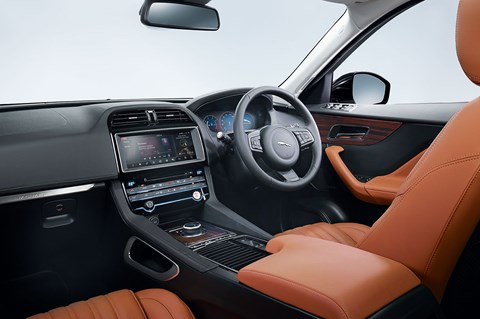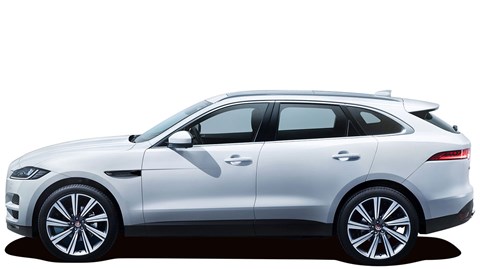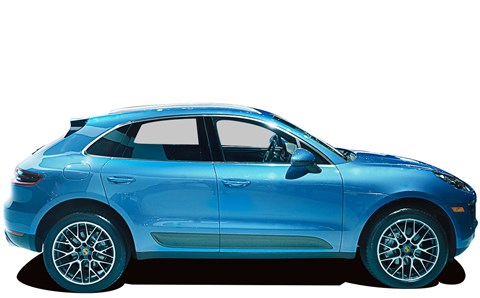► 2016’s most wanted cars #14 Jag F-Pace
► Could it topple the Porsche Macan as the driver’s choice?
► The full lowdown on the new Brit SUV
The Macan is magic. It’s laid down a mark
Is it absurd that an SUV needs to be exciting to drive? Not these days, so Jaguar’s F-Pace doesn’t have any choice but to compete. To avoid undermining 70-odd years of hard-earned brand identity, to justify the ‘practical sports car’ marketing blurb and to help differentiate it from its Range Rover twin a little further down the pipeline, F-Pace needs to be ballerina-nimble. And that means taking on the Porsche Macan, the dynamic benchmark not just for the 4×4 genre but a car agile enough to outpoint more than a few sports cars too. Jaguar’s anything but shy about the F-Pace’s credentials, however. It won’t just match Macan, but beat it, says Jag – and it’s using stats to prove it.
The chassis sounds competitive
Compared with the Macan’s Audi Q5-sourced foundations, the F-Pace’s modular underpinnings have given the engineering team more freedom – to put the wheels in the best place for handling and interior space, and the pillars in the best place to see round – and fewer body-in-white hardpoints to work around. If the raw numbers are anything to go by, there are multiple dynamic wins too. Jaguar claims the F-Pace’s double-wishbone front suspension possesses a whopping 50% greater lateral stiffness than that of the Porsche, and its integral-link rear 35%. Weight distribution is a dreamy 50:50, and the wheelbase is longer than the Macan’s – good for ride quality, for interior space and for more predictable handling.

Pace isn’t a misnomer
F-Pace hasn’t just borrowed the F-type’s tail lights but its 3.0-litre supercharged V6, too. Go for the top 375bhp S variant and 62mph’s come and gone in 5.5sec. Porsche’s 395bhp Macan Turbo range-topper is swifter by 0.8sec, but don’t be surprised to see a pacier-still SVO-developed F-Pace lock horns with it a little further down the line.
Meanwhile, the 296bhp, 516lb ft V6 diesel F-Pace is hardly a slowcoach, despatching the benchmark sprint in 6.2sec. And the four-pot Ingenium diesel volume sellers juggle a useful 318lb ft with a fleet-friendly 129g/km CO2 rating. Porsche doesn’t have a four-pot Macan diesel: 161g/km is as low as its V6 can go.
It’s good for the planet (kind of)
Jaguar really likes aluminium, and the F-Pace contains more of it than any other crossover. 80% of its body-in-white is made from the stuff, 33% of which is recycled. The bare shell weighs 298kg, and model-for-model the F-Pace is lighter than its closest rivals, although perhaps not by quite as much as you might expect. Base rear-wheel-drive diesel models start from 1665kg; add around 100kg for four-wheel drive. Still, the lightest of the Macans weighs in at 1845kg.
Grace, pace – and actual space
It’s not just about Porsche-chasing: the F-Pace also needs to match X3, Q5 et al for comfort, practicality and showroom appeal. The numbers look promising here too; it might be an X3 rival, but the (admittedly larger) Jag’s 650-litre boot is more comparable to an X5’s. And seats down, its 1740 litres and Ikea-friendly 1.8m-plus load-length both out-cargo the Q5. Jaguar reckons there’ll be no passenger too lanky for the rear cabin, and that they’ll have to put up with less noise there than in a Q5 or X3 (and 6dB less than in a Macan, Jag’s at pains to point out).

All the toys
Tether up to eight devices to in-car wi-fi, plug them into four USB points, marvel at widescreen 360-degree street-view navigation on the instrument cluster, or check how much fuel you’ve got on your smartphone… there’s enough gadgetry within the F-Pace to keep you thumbing through the manual for years. And if you’re a fan of touchscreens, the 10.2in behemoth in the dashboard’s as big as it gets in the 4×4 class. Meanwhile, the F-Pace’s stereo cameras can keep it within its lane, clock pedestrians and pump the brakes automatically with the best of them.
It can out-bling all-comers
Like big wheels? F-Pace obliges with the sector’s biggest, ranging from CO2-friendly 18s right up to penny farthing-spec 22s. Opt for the marginally more demure 21 and 20in rims and, thanks to deliberately plumper-than-average sidewalls, Jaguar claims the F-Pace offers greater kerbing protection than you know who.
But the best numbers of all? F-Pace starts at £34,170, and maintains a £6k advantage over the Porsche up the range. If the F-Pace lives up to Jaguar’s words – and figures – it should be very special. We’ll find out in the spring.
The numbers game: F-Pace vs Macan

Jaguar F-Pace S 3.0 Supercharged
Price: From £51,450
Power/torque: 375bhp/332 lb ft
Performance: 5.5sec 0-62mph, 155mph (limited)
MPG/CO2: 31.7mpg, 209g/km CO2
Drag coefficienct: Cd 0.34
Weight: 1861kg
Power-to-weight raitio: 202bhp per tonne
Boot space (seats up/down): 650/1740 litres

Porsche Macan Turbo (3.6)
Price: £60,994
Power/torque: 395bhp/406lb ft
Performance: 4.8sec 0-62mph, 165mph
MPG/CO2: 30.7mpg, 216g/km CO2
Drag coeffienct: Cd 0.37
Weight: 2000kg
Power-to-weight ratio: 198bhp per tonne
Boot space (seats up/down): 501/1500 litres